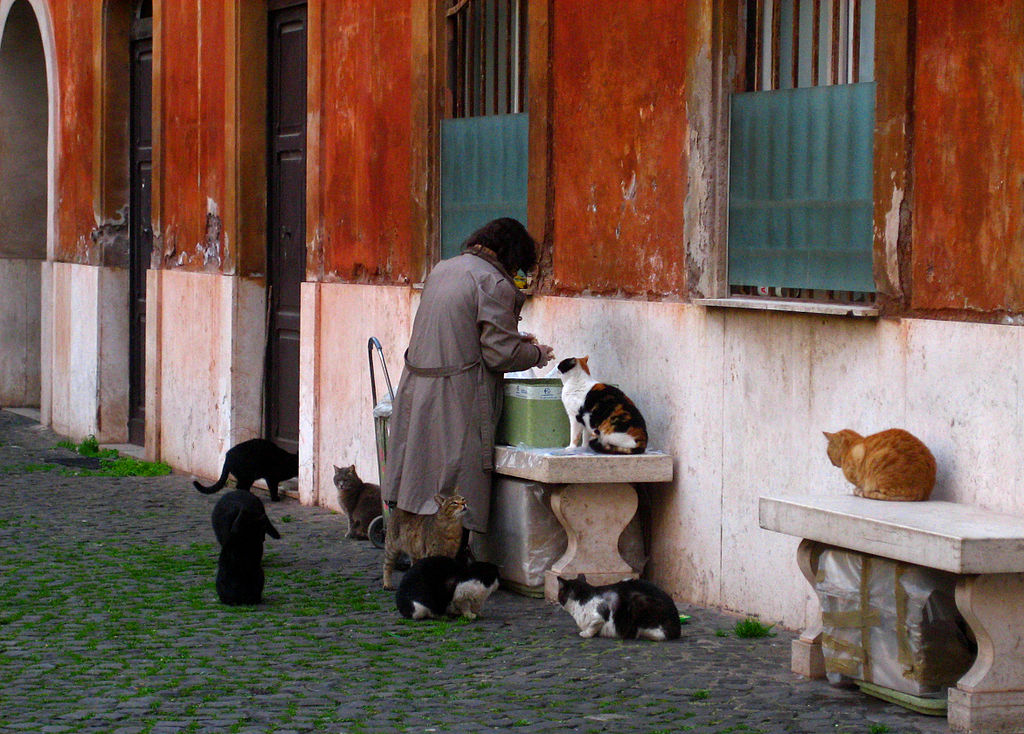
Catlady Confidential
I’m sitting here on the sofa right now. Two cats have curled themselves up against my hip, and two more are lying along the back of the couch behind my head. If past experience is an indicator, I’ll be interrupted numerous times while writing by my two bald attention seekers. I guess having four cats qualifies me as a catlady? Maybe – or maybe you have to be crazy?
There’s a lot more to being a true catlady than just having a few cats. In fact most people picture a catlady as keeping an excessive number of cats, like 10 or more. I don’t see it that way, because for example, a farmer might keep many cats in his barn to control rodents. Is he or she a catlady? It all depends on the circumstances. Ten cats living in a one bedroom apartment would be too many as far as I’m concerned. Ten cats in a big house? That might be OK for some people. The real definition of “too many cats” would be “more cats than the owner can properly take care of and keep sanitary”.
Another misconception about catladies is that they are always mentally ill, out of control cat hoarders, and some of them are. I believe that to be a catlady you have to have some level of obsession with cats. I know I do.
How I Became A Catlady
My obsession stems from my childhood. I grew up in an emotionally abusive, cold family with four siblings. My parents assigned me the role of scapegoat, bottom of the pecking order. The family ignored me unless someone wanted an emotional punching bag or someone to do a chore nobody else wanted to do. Back then, my undiagnosed bipolar disorder manifested itself as giftedness and self isolation. I was reading encyclopedias and speaking four syllable words and complex sentences while still in diapers. Needless to say, this made me very different from others. People stared at and shunned me. I couldn’t relate to anyone else, and I didn’t feel like a true member of the human race. I learned at a very young age to keep to myself and avoid human company, otherwise I could suffer another round of emotional and physical abuse. Needless to say it was a very lonely childhood – at least until I discovered the companionship of cats.
When I was growing up, we only ever had one breed of cat – the Siamese. Siamese have different personalities from most other breeds. They tend to prefer one person in the household, and they bond very closely with that person. They can even develop separation anxiety. My current Siamese, Victor, becomes upset if I shut myself in the bedroom for too long (I forbid the cats from entering my bedroom because I keep a couple of bird cages and some large plants which the cats used to chew). He will sit outside the door and yowl until I come out. Because I was such an introvert and spent most of my spare time reading quietly, the Siamese cats bonded to me and spent a lot of time sleeping on or beside me. Of course, I bonded to them as well.
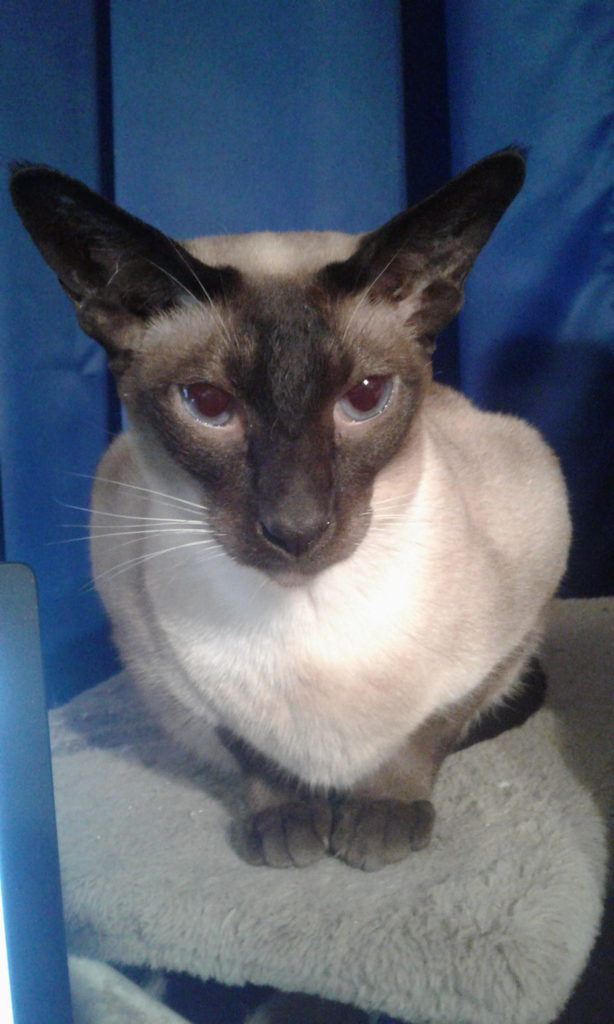
Since cats don’t live as long as humans, and I’m in my mid fifties now, I’ve had to go through losing a number of beloved cats, Siamese or not. Each loss is just as upsetting for me as the rest. I’m obsessed with losing them. It’s something I’m trying to work through on my own. Often when I’m spending time with my cats I suddenly start thinking about how they will die and how I will feel about losing them. It’s like pre-emptive grief, trying to prepare for a terrible loss by pre-grieving so that hopefully it won’t hurt as much when the death actually happens.
The thought of anything happening to them, or any cat, causes me a lot of distress. I get very upset if I hear a kitten crying, or if I read in the news about a kitten being mistreated. Now I keep telling myself to enjoy their companionship NOW, and worry about their demise LATER. I remind myself that obsessing over their loss takes away from enjoying them now, and isn’t fair to them. This is what I tell myself whenever I get that pang of sadness in my chest, and gradually those pangs are becoming less frequent.
Cat Hoarder vs. Catlady
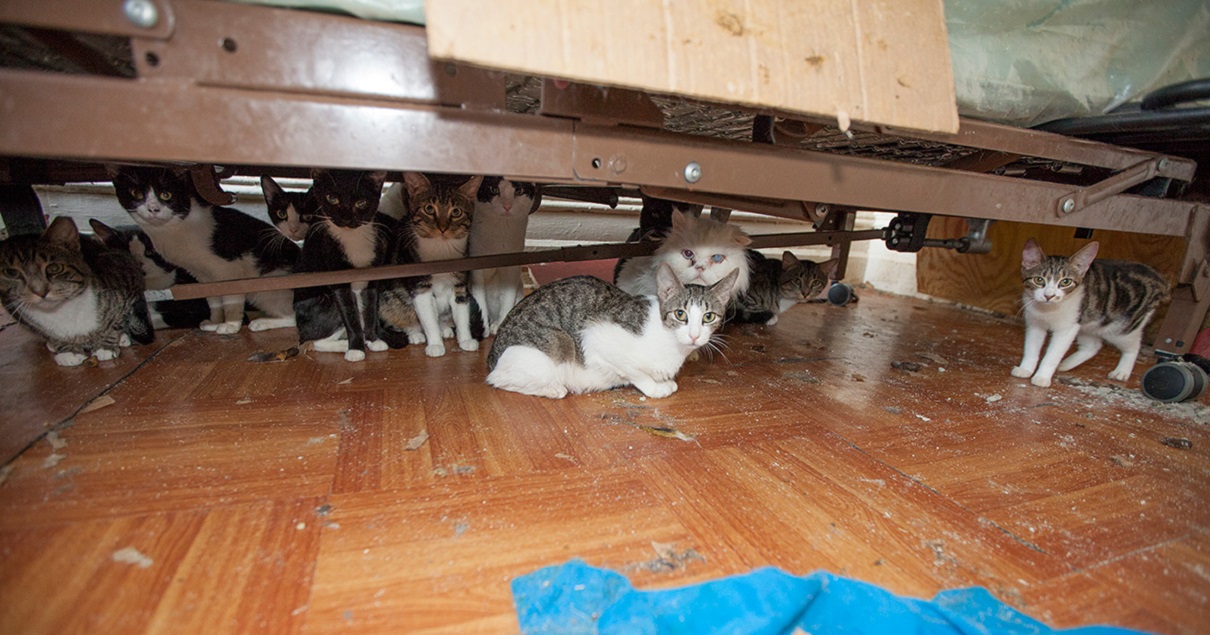
I coped with my illness and unpleasant childhood by forming deep bonds with the family cats. However, there are a lot of cat ladies who aren’t mentally ill. Keeping cats as companions and being a woman doesn’t necessarily make you a cat lady, unless you want to be. People confuse pet hoarding caused by mental illness with being a cat lady. But pet hoarding can involve a variety of species including dogs, and even a mixture of species such as cats, dogs and birds or reptiles. The big difference is that a cat lady can choose how involved she is with her pets. A pet hoarder is sick and has lost touch with reality. They have no choice. They’re in denial about the number of pets they have, the mess, and their ability to handle and afford caring for so many pets. Pets in their care die of starvation, filth, disease and neglect. Pet hoarders refuse to consider sensible measures to get their situation under control, such as rehoming excess pets, getting remaining pets spayed or neutered, and getting help to clean up their domicile. They avoid family members and those who try to help. They obsess over their pets, to the point that some even keep the mummified bodies of deceased pets.
Catlady History
The earliest accusations against crazy cat ladies were of witchcraft, when they were usually harmless old ladies who fed strays or kept a few cats in their homes. In those times, people often viewed cats as evil or bad luck, and they drowned many catladies and their cats or burned them at the stake. In modern times the stereotype has been that all women who keep multiple cats are insane cat hoarders. The image of Eleanor Abernathy, the “crazy cat lady” of the Simpsons personifies this viewpoint.
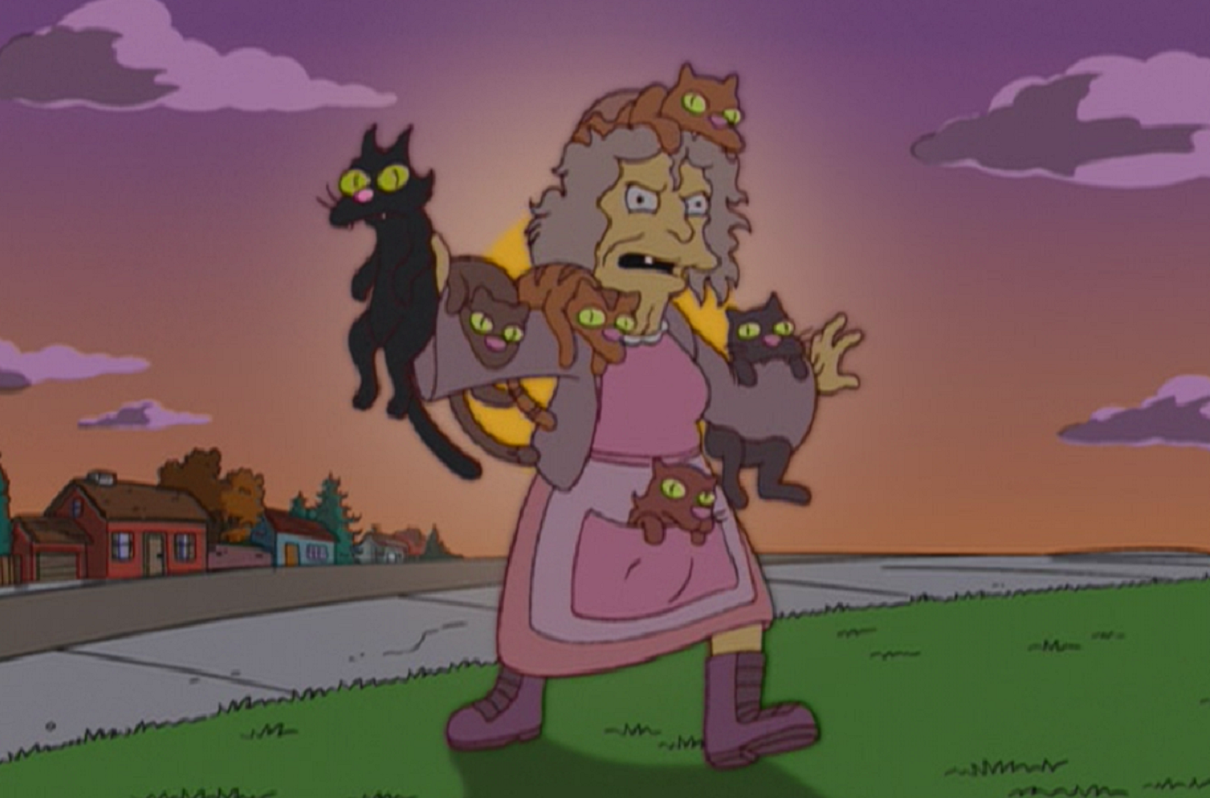
To reinforce the crazy catlady stereotype, in the early 2000’s there was a lot of media hysteria about toxoplasmosis parasites from cat feces driving cat ladies crazy. This article from a well known fake news tabloid is one example designed to whip up hysteria about cats giving their owners schizophrenia over time, caused by toxoplasmosis. In reality, the human immune system usually kills any infestation, and only people with depressed immune systems and pregnant women should avoid touching cat feces. In the meantime, this study refutes the notion that people who own cats develop mental illness later in life, from toxoplasmosis or any other cat-related cause. Still, despite other such studies being released in 2017, there are still plenty of nonsensical articles about cat ladies and schizophrenia from toxoplasmosis circulating among the fake news peddlers.
The reputation of the catlady is starting to improve. In fact, studies are emerging that link cat ownership to improved health, including mental health. There are many ways that cat companionship and caring for cats improve both physical and mental health. Here are some ways they’ve improved my own health:
-
- Companionship. I’m a very isolated person, with no family or friends in my life. I can’t work. It’s not easy to go looking for human friends when eventually I’ll have to tell them about my mental illness. I’d be miserably lonely, depressed, and probably suicidal without my cats. My cats like to be around me, they don’t care that I have bipolar disorder.
- Keeping me grounded. When I’m manic my brain flies off in several directions at once, and I have a hard time focusing on one thing at a time. I take on many projects at a time and sometimes lose track of what I’m doing. When I am depressed, I lose the will to do anything, even to get out of bed. My cats are a constant in my life, no matter what I’m doing I still have to stop and pay attention to them and make sure they are fed and their litter boxes are clean. My daily routine includes their feeding times and the time I clean the litter boxes. No matter how high or low my mood is, I can always appreciate and care for my cats.
- Calming and de-stressing. There’s nothing more soothing than the sound of a cat’s purr. Right now one of my Sphynx cats has curled up behind my shoulder on the couch, purring in her sleep. If something upsets me or my mind gets too worked up, stroking a cat’s fur (or skin) is very soothing and brings my mind back to Earth.
- Pain relief. A Sphynx cat’s skin is a lot warmer than a regular cat’s fur. I find the warm penetrating heat on my lap is relaxing. It also helps with my achy legs and knee arthritis pain. I sometimes get painful intestinal cramps. Having a cat sitting on my lower belly helps soothe and relieve those cramps.
- Cardiovascular health. Contact with felines, involving stroking their fur, being next to their warmth, and hearing them purr has been shown to lower blood pressure and reduce the risk of heart attack and stroke.
- A source of fun. It’s fun to play with a cat, or to watch them play with each other or objects they find. I also like to take photos of them and draw them. One of my hobbies is to collect eclectic cat-related items and clothing. I’ve been collecting cat stuff since I was 8 years old, when I saved up my allowances to buy Siamese cat salt and pepper shakers. I have a winter hat with cat face and ears. People stop me to ask about it every time I wear it. Recently I couldn’t resist buying an over the top pair of kitty sneakers from Irregular Choice.
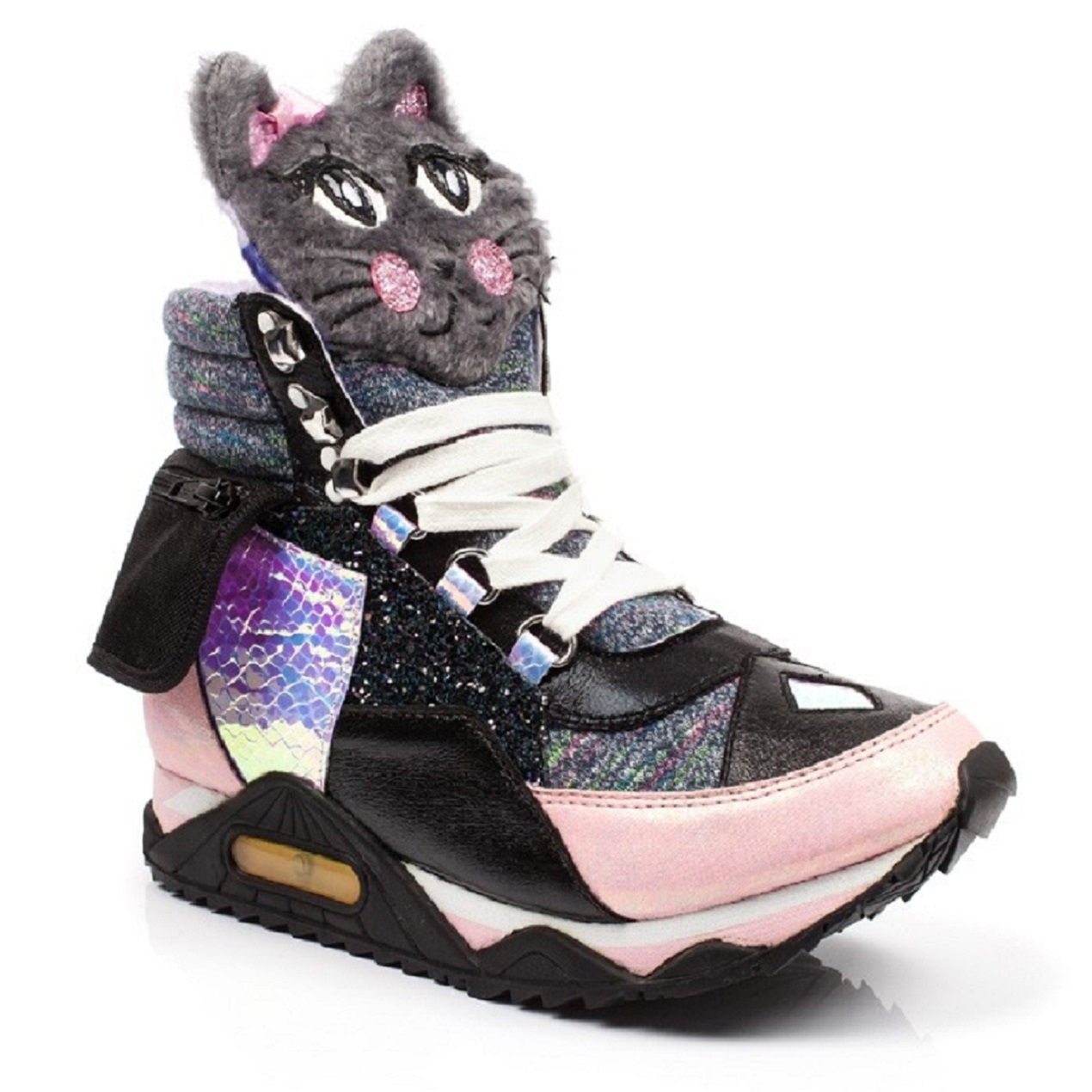
Not only are the stereotypes about “crazy catladies” starting to disappear, people are embracing the moniker. A veritable industry of catlady merchandise and services has sprung up. For example, if I wished, I could subscribe to CatLadyBox.com and receive a box full of catlady goodness every month. A quick online search for “cat gifts” or “cat merchandise” will reveal a plethora of retailers featuring cat related items for the discriminating catlady.
So despite all of the misconceptions and stereotypes, being a catlady isn’t so bad. I’m happy and proud to be a catlady – crazy or not!

